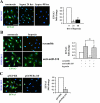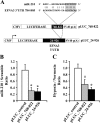MicroRNA-210 modulates endothelial cell response to hypoxia and inhibits the receptor tyrosine kinase ligand Ephrin-A3
- PMID: 18417479
- PMCID: PMC3259646
- DOI: 10.1074/jbc.M800731200
MicroRNA-210 modulates endothelial cell response to hypoxia and inhibits the receptor tyrosine kinase ligand Ephrin-A3
Abstract
MicroRNAs (miRNAs) are small non-protein-coding RNAs that function as negative gene expression regulators. In the present study, we investigated miRNAs role in endothelial cell response to hypoxia. We found that the expression of miR-210 progressively increased upon exposure to hypoxia. miR-210 overexpression in normoxic endothelial cells stimulated the formation of capillary-like structures on Matrigel and vascular endothelial growth factor-driven cell migration. Conversely, miR-210 blockade via anti-miRNA transfection inhibited the formation of capillary-like structures stimulated by hypoxia and decreased cell migration in response to vascular endothelial growth factor. miR-210 overexpression did not affect endothelial cell growth in both normoxia and hypoxia. However, anti-miR-210 transfection inhibited cell growth and induced apoptosis, in both normoxia and hypoxia. We determined that one relevant target of miR-210 in hypoxia was Ephrin-A3 since miR-210 was necessary and sufficient to down-modulate its expression. Moreover, luciferase reporter assays showed that Ephrin-A3 was a direct target of miR-210. Ephrin-A3 modulation by miR-210 had significant functional consequences; indeed, the expression of an Ephrin-A3 allele that is not targeted by miR-210 prevented miR-210-mediated stimulation of both tubulogenesis and chemotaxis. We conclude that miR-210 up-regulation is a crucial element of endothelial cell response to hypoxia, affecting cell survival, migration, and differentiation.
Figures






References
-
- Pouyssegur, J., Dayan, F., and Mazure, N. M. (2006) Nature 441 437-443 - PubMed
-
- Pugh, C. W., and Ratcliffe, P. J. (2003) Nat. Med. 9 677-684 - PubMed
-
- Kulshreshtha, R., Davuluri, R. V., Calin, G. A., and Ivan, M. (2008) Cell Death Differ. 15 667-671 - PubMed
-
- Bartel, D. P. (2004) Cell 116 281-297 - PubMed
Publication types
MeSH terms
Substances
LinkOut - more resources
Full Text Sources
Other Literature Sources
Molecular Biology Databases

